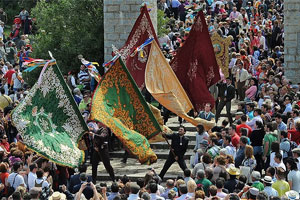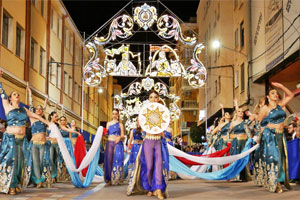Madrid Transhumance Festival
What is the Transhumance Festival?
Since 1994, this event has been advocating for the role of transhumance and extensive livestock farming as tools for biodiversity conservation and combating climate change.
This festival was initiated in 1994 to contribute to the approval of the new Livestock Paths Law by the Spanish Parliament, recognizing "cañadas," "cordeles," and "veredas" as public domain assets and a unique heritage in the world. It is organized by the Transhumance and Nature Association, with collaboration from the Mesta Council Association, MAVA Foundation, Madrid City Council, and WWF / Adena Spain Foundation.
The Madrid Transhumance Festival is an annual event celebrating one of the oldest and most distinctive traditions of the region: transhumance. Transhumance is the seasonal movement of livestock from breeding areas to grazing areas, and vice versa, which has been a fundamental practice in the pastoral culture of the Community of Madrid and both Castiles for centuries.
The festival generally takes place in the center of the city of Madrid and its surroundings, where this ancient rite is reenacted with a parade of livestock through the historic streets of the city center. The shepherds wear traditional costumes and lead their flocks of sheep and goats. Additionally, various activities related to rural life and livestock are organized, such as displays of local products, tastings of typical food, contests, and exhibitions of pastoral skills.
This celebration has a significant cultural and educational component, as it seeks to preserve and promote knowledge about transhumance and its historical and cultural relevance in the Community of Madrid.
What to See in Madrid
Madrid is a city rich in culture, history, and nightlife. Here is a list of places and activities you might consider during your visit to Madrid:
- Prado Museum: One of the most important art museums in the world, housing an extensive collection of masterpieces by artists such as Velázquez, Goya, Rembrandt, and many more.
- Reina Sofía Museum: Dedicated to contemporary art, it stands out for its impressive collection of works by Spanish artists like Picasso and Dalí.
- Royal Palace: The official residence of the Spanish monarchy, it is an impressive building with magnificent interiors and beautiful gardens.
- Plaza Mayor: A historic square in the city center, surrounded by period buildings and full of life and activity.
- Retiro Park: An extensive park in the city center where you can take a boat ride on the pond, visit the Crystal Palace, and enjoy concerts and outdoor activities.
- Puerta del Sol: The heart of Madrid, a famous square known for being the zero kilometer point of Spain and for housing the statue of the bear and the strawberry tree.
- Gran Vía: One of the most famous streets in Madrid, known for its shops, theaters, and impressive architecture.
- San Miguel Market: A covered market where you can try a wide variety of Spanish dishes and buy local products.
- Debod Temple: An ancient Egyptian temple that was dismantled and relocated to Madrid. It's a popular spot for watching the sunset.
- Literary Quarter (Barrio de las Letras): A historic neighborhood where many famous writers like Cervantes and Lope de Vega lived. Here you'll find cobblestone streets and a plethora of bars and restaurants.
- La Latina Quarter: A lively neighborhood known for its bohemian atmosphere, tapas bars, and narrow streets.
- Santiago Bernabéu Stadium and Wanda Metropolitano Stadium: If you're a football fan, you might consider visiting the stadiums of Real Madrid and Atlético de Madrid, respectively.
- Almudena Cathedral: An impressive cathedral located next to the Royal Palace, blending architectural styles and offering panoramic views from its towers.
- Círculo de Bellas Artes: A cultural center offering exhibitions, concerts, cinema, and a rooftop terrace with spectacular views.
- Dos de Mayo Art Center (CA2M): A contemporary art museum located in Móstoles, a municipality near Madrid, showcasing works by contemporary artists.
The city offers a wide range of experiences to cater to the tastes of everyone, from art lovers to food enthusiasts and nightlife aficionados.
What to Eat in Madrid
Here is a list of typical dishes and meals you should consider trying when visiting the city:
- Bocadillo de calamares: A roll filled with fried squid rings, a classic of Madrid's fast food.
- Cocido madrileño: A traditional stew combining chickpeas, chorizo, black pudding, pork, and vegetables. It's usually served in three stages: first the soup, then the chickpeas and vegetables, and finally the meat.
- Tortilla de patatas: A classic Spanish omelette made with eggs and potatoes, sometimes with added onions. It's a simple but delicious dish.
- Gambas al ajillo: Shrimp sautéed in olive oil with garlic and chili, giving them an intense and delicious flavor.
- Callos a la madrileña: A stew made with beef tripe, chorizo, black pudding, and paprika. It's a hearty and flavorful dish.
- Cocido montañés: Although originally from Cantabria, it's very popular in Madrid. It consists of a stew of white beans, kale, potatoes, and pork.
- Soldaditos de Pavía: Battered and fried cod, a tasty and crispy dish often served with padrón peppers.
- Huevos rotos con jamón: Fried potatoes with eggs and pieces of Iberian ham on top. The eggs are broken over the potatoes to create a delicious mix.
- Cochinillo asado: A typical dish of the region, it's a roasted suckling pig that turns out very tender and flavorful.
- Madrileños: Pastries filled with custard cream and glazed, they are a very popular dessert in the city.
- Churros con chocolate: A traditional breakfast or snack, churros are fried dough sticks served with a cup of thick hot chocolate for dipping.
- Rabo de toro: Bull's tail stewed slowly until the meat becomes tender and served in a rich and flavorful sauce.
- Pimientos del padrón: Fried green peppers seasoned with coarse salt. They are known for their mild flavor, but one in every ten tends to be spicy.
- Sopa de ajo: A traditional soup made with garlic, eggs, and bread, often served with ham.
These are just some examples of the rich gastronomic offerings that Madrid has to offer. Don't hesitate to explore local markets like San Miguel Market or Cebada Market to discover a wide variety of dishes and flavors.





